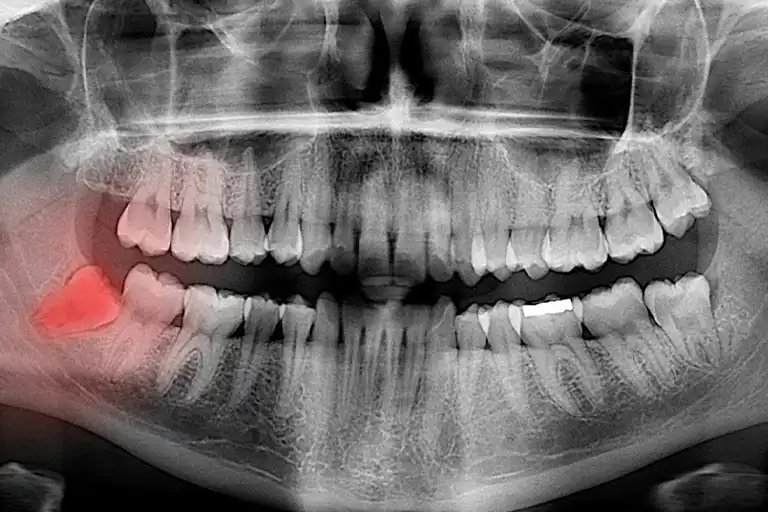What is a dentigerous cyst?
If you want to know the second most common jaw cyst, you should be well aware of dentigerous cyst. Dentigerous cyst is the cyst which develops in the surrounding tissues of your unerupted tooth. They are the second most common jaw cyst after periapical cyst. Dentigerous cyst occurs around the crown of the unerupted and impacted teeth, teeth that are buried in your jaw bone and gum tissues.
Your canine and wisdom teeth are the most affected by dentigerous cyst because these are the most commonly impacted teeth. Your dentist will diagnose the cyst through necessary radiographic images.
They may need certain testing and specific check-ups to rule out the possibility of numerous other jaw cysts and tumors. This cyst should not go untreated because of serious complications that can follow in its high-risk conditions.
Dentigerous cyst symptoms
Dentigerous cysts can be a few millimeters in size or grow to 2 centimeters or even bigger in rare occasions. Since this cyst is associated with impacted teeth beneath oral and jaw tissues, it can remain unnoticed most of the time. Your dentist can notice that by taking radiographic images like X-rays and CT scans. But you can discuss with your dentist if you see the following signs and symptoms:
- Delayed eruption of a tooth
- Swelling
- Sensitivity and irritations in your oral tissues
- Teeth displacement in the impacted tooth area
- Abnormal space and gap between teeth
What causes dentigerous cyst?
Dentigerous cyst is caused by the increase of remaining enamel fragments in the unerupted tooth. Dentists may not pinpoint to a precisely known cause and why this cyst happens. When a tooth fails to erupt, the fragments of enamel tissue can proliferate and accumulate fluid, forming a cystic lesion around the crown. It attaches to the cervix of unerupted tooth at the cementoenamel junction and then forms a fluid-filled cyst.

Who is likely to get dentigerous cyst?
Dentigerous cyst is likely in every individual from children to various age groups as long as there is an unerupted or impacted tooth in their jaws. The incidence of this cyst, but, gets higher in individuals in their 20s and 30s of their age.
Those who have wisdom teeth and other unerupted teeth buried in their mouth are susceptible individuals. They should have their mouth checked regularly to detect the underlying cyst development early on.
Dentigerous cyst and eruption cyst: what is the difference?
Eruption cyst is the soft cyst version of dentigerous cyst. Eruption cyst (as the name suggests) occurs in both erupting primary and permanent teeth. Since the problem is associated with erupting teeth, children are the targeted age group. The cyst appears as a swelling over the tooth that is going to erupt and usually turns blue or black in color.
Your child may wait a bit more for the eruption of the tooth, so the tooth will break the cyst. If your kid feels unpleasant about the cyst, have your dentist cut and drain the fluid.
What are the complications of dentigerous cysts?
An untreated dentigerous cyst can have serious complications such as:
- Root resorption of other teeth
-
Dentigerous cysts can enlarge and resorb the roots of other teeth around, meaning the cyst destroys the cementum layer of the adjacent tooth first and can harm dentin or maybe the pulp in its final root resorption strike.
- Infection
-
A dentigerous cyst like other cysts can lead to infection if not diagnosed at the right time. The infection can cause serious oral health risks in the surrounding oral tissues, your gums, and jaw.
- Jaw fracture
-
Both dentigerous cyst and the impacted third molars (wisdom teeth) can weaken the lower jaw bone. The impacted tooth fills the space in the jawbone area with more bone. Thus, in the presence of the cyst, the jaw is weakened and will fracture.
- Tooth displacement
-
Untreated dentigerous cyst like all impacted tooth can damage other adjacent teeth nearby. It can cause the displacement of teeth into abnormal positions. When the cyst surrounds a wisdom tooth in the jaw, it can displace the tooth to areas such as the sinus, jaw edges, and oral soft tissues around, which is considered a high risk.
- Ameloblastoma (tumors)
-
Ameloblastoma is a benign jaw tumor that can swell into your jaw and must be treated. The untreated dentigerous cyst may cause or trigger these tumors occasionally, so have your cyst removed before any more destructive oral risks happen.

How is dentigerous cyst treated?
Surgical removal of affected tooth and the cyst is the common treatment for dentigerous cyst. Usually, the treatments can be done through:
- Enucleation
-
Enucleation is the process in which the cyst is entirely removed without rupturing the cyst and the total removal of the affected tooth is also done. This procedure is especially suitable in small dentigerous cysts.
- Marsupialization
-
If the cyst is large, your oral surgeon can do marsupialization along with enucleation. In marsupialization, a cut is done on the wall of the cyst to drain the fluid and then stitches are added to continue the drainage.
- Orthodontics
-
If it is possible for the tooth to be saved and its eruption, your orthodontist will take control of the situation. After the cyst is removed by the oral surgeon, orthodontists can manage the eruption of the tooth.
How to prevent dentigerous cyst?
Although it is difficult to know when a dentigerous cyst begins to grow, you can still preserve your oral and dental health by regular dental check-ups. Your dentist will take X-rays, CT scan, or even MRI scanning of your jaw and of the potential location of the dentigerous growth.
Having an impacted wisdom or canine tooth or other teeth that haven’t erupted into your dental arch cry out for more of your attention. If you have an unerupted tooth hidden in your jaws and gums, see your dentist to prevent risks of developing a cyst to a minimum. During the radiographic imaging, your dentist will detect the cyst and take the proper series of actions for the treatment.
